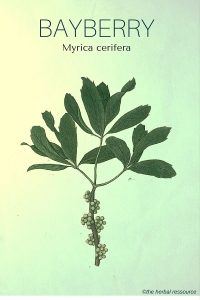Bayberry contains triterpenes (such as taraxerol, taraxeron and myrikadiol), flavonoids (myricitrin), tannins, phenols, resins and rubber substances.
The European settlers who came to North America learned about the medicinal properties of bayberry from the Native Americans.
A description from 1737 states that the plant “removes air and relieves all kinds of pain caused by cold, and is a good remedy for colic, paralysis, convulsions, epilepsy and other disorders.”
The root bark of bayberry was listed in the United States Pharmacopeia from 1916 to 1936.
Some herbalists still use this herb as a treatment for a variety of ailments and diseases due to its reputation as an internal stimulant and also for its antipyretic and astringent properties. Bayberry can therefore be used to treat diarrhea and inflammation and infections of the gastrointestinal tract.
The herb has been used traditionally as a treatment for headaches, and it was used as a decongestant for colds, flu, cough, throat infections and sinusitis.
Externally, a decoction made from the herb was used to cover slow healing wounds, hemorrhoids and varicose veins. Once, large doses were used to induce vomiting as a treatment for poisoning.
Modern research studies have confirmed that bayberry does contain astringent and antibacterial substances. The astringent effect is due to the tannin found in the plant and explains why the herbs was once a popular remedy for diarrhea, sores, and hemorrhoids (tannin is also know to curb intestinal inflammation).
Laboratory experiments have shown that the flavonoid myricitrin can stimulate bile flow, a trait which sometimes can be useful for ailments related to the liver and gallbladder.
Myricitrin has also the ability to kill micro-organisms, but what impact that may have in treating diseases is yet unclear and more studies are needed.
A wax can be obtained from the berries by boiling them in water making the wax float on the surface, where it can then be easily skimmed off.
This wax can be used, among others things, to make candles that give off a pleasant balsam-like fragrance when burned. Around four kilograms (around 9 pounds) of berries are needed to produce one kilogram (2,2 pounds) of wax.
The wax also had its uses as a medicine and was used traditionally as a remedy for dysentery and to treat ulcers in the digestive system.
Herbal Resource
Latest posts by Herbal Resource (see all)
- What is Maritime Pine Bark used for? - December 23, 2023

Leave a Reply